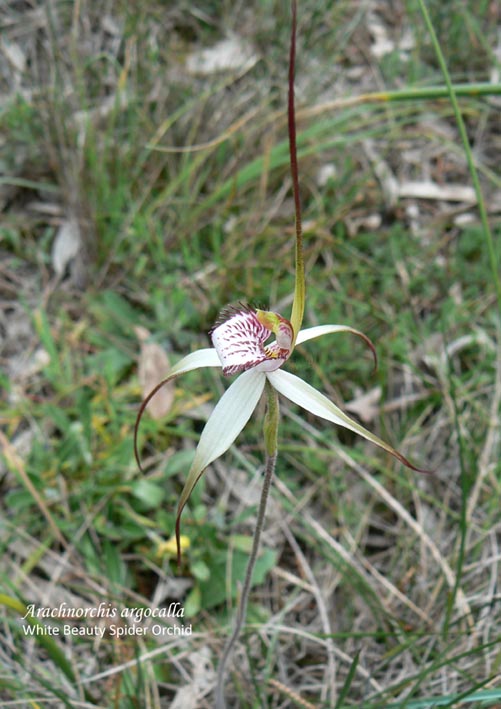Quite a few pictures were entered this month.
Ricky Egel’s Thelymitra x irregularis, 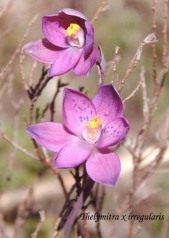
Pauline Myer’s Caladenia falcata and Caladenia carinsiana; 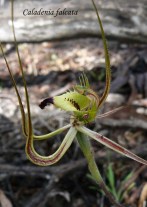
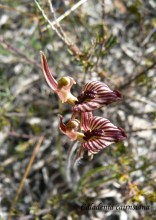
Margaret Lee’s Diuris orientis and Nemacianthus caudatus;
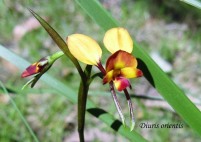
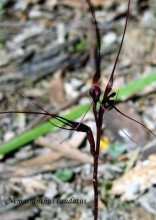
Judy Sara’s Arachnorchis tensa;
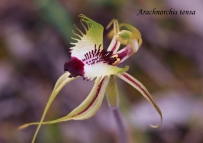
Greg Sara’s Arachnorchis stricta which had an unusual green coloured flower;
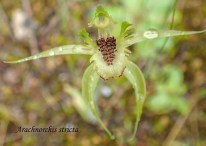
and Helen Lawrence’s Arachnorchis argocalla.
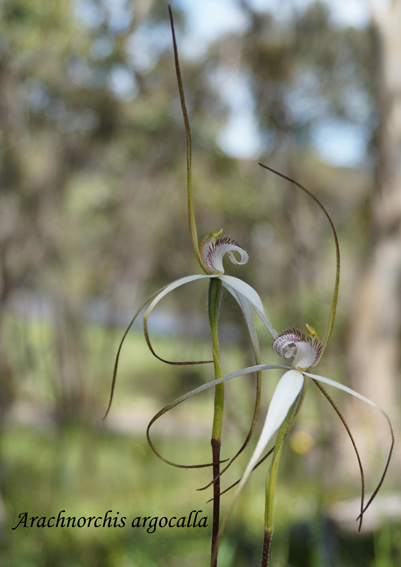
Helen’s picture of the nationally endangered A. argocalla was the outstanding winner. Now known as the White Beauty Spider Orchid^, it was featured last year as a winner with Pauline Meyer’s June 2015 entry*.
This is one of our largest spider orchids. For size, beauty and delicacy it rivals the Western Australian Caladenia longicauda ssp. eminens (White Stark Spider Orchid) and A. venusta, syn. Caladenia venusta (Graceful Spider Orchid) from Victoria and the South East.
It shares many similarities with these two species in that they are reasonably good size white flowers with a stiffly hinged labellum that has long, thin teeth and the segments have threadlike tips without clubs. It is separated both geographically and in the type of habitat from these two species. A. argocalla is a plant of the inland hills and valleys.
Though primarily a white flower and part of the A. patersonii complex, A. argocalla has red colouring in the labellum which according to Backhouse may possibly indicate genetic introgression (that is long term mixing of the gene pool) with either the A. reticulata or A. leptochila complexes. Certainly, the colour of the labellum was quite variable ranging from white through to a deep red.
^Previously known as Common White Spider Orchid because of its abundance but now only known to a limited number of locations.
*NOSSA Journal, July 2015
Reference:
Department of the Environment (2016). Caladenia argocalla in Species Profile and Threats Database, Department of the Environment, Canberra. Available from: http://www.environment.gov.au/sprat. Accessed Thu, 3 Nov 2016 16:31:39 +1100
Introgression https://en.wikipedia.org/wiki/Introgression Accessed 4 November 2016
Bates, R. J., ed. (2011). South Australian Native Orchids. Electronic version, 2011. NOSSA
Jones, David L (2006) A complete Guide to Native Orchids of Australia, Frenchs Forest, NSW: Reed New Holland
Backhouse, G (2011) Spider-orchids the Genus Caladenia and its Relatives in Australia
NB: November Competition will be judging the monthly winners from this year.


